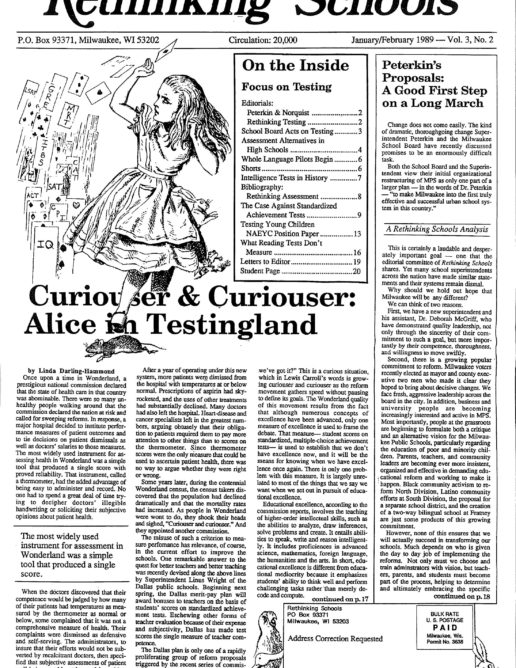The Mismeasure of Man
Nostalgia is a common affliction. Whether we fondly recall a less polluted landscape, stronger family bonds, or schools that truly educated, the past, or its illusion, evokes better days. On the other hand, when it comes to matters of science, we maintain our superiority over the primitive, even laughable techniques of times past.
Good history, however, tries to suspend the tendency to romanticize or condemn - at least until it has uncovered what happened and why. This is what Stephen J. Gould does in The Mismeasure of Man. Widely celebrated since it was published eight years ago, his history of intelligence testing helps us look beyond changes in technique to the social assumptions that undergird scientific practice.
Gould traces the history of mental measurement from Samuel George Morton’s efforts to determine intelligence by measuring the capacity of skulls, to the mass testing of army recruits during World War 1, to studies of identical twins raised in different environments, and finally to the contemporary technique of factor analysis. This romp through various efforts to measure “man” uncovers much that today appears hilarious or bizarre. Cesare Lombroso, for instance, maintained that animal-like physical characteristics were the mark of a “criminal mentality.” Since he believed that criminality traced to atavistic characteristics of animals in humans, then animals must have engaged in criminal behavior. In what Gould calls “the most ludicrous excursion into anthropomorphism ever published, …he [Lombroso) cites, for example, an ant driven by rage to kill and dismember an aphid; an adulterous stork who, with her lover, murdered her husband; a criminal association of beavers who ganged up to murder a solitary com patriot…”
Similar foolishness was displayed by Lewis Terman, the professor whose Stan ford-Binet examination, according to Gould, “became the standard for virtually all ‘IQ’ tests that followed.” One Terman project involved measuring the IQs of famous dead people. The scores of those who came from poor backgrounds were lowered on the assumption that they must have inherited some of the presumed inferior genes of their parents. Those who rebelled in school also lost points.
Terman ‘s project reveals biases prevalent among those who developed tests of intelligence. They believed that the social order was just. Those stationed at the bottom were not there due to injustices of race, class, and gender, but because of inferior endowment. This group of scientists, incidentally, included C.C. Brigham, the developer of the SAT.
At times social biases led to fraudulent practice. Henry Goddard doctored photographs of descendants of. “the illicit union of an upstanding man with a supposedly feeble-minded tavern wench” to make it appear that “feeble-mindedness” was inherited. Cyril Burt simply fabricated data to demonstrate that nature was more important than nurture: He invented identical twins raised separately. (Gould points out that Burt’s falsified data were central to Arthur Jensen’s well-known and still influential 1969 article maintaining that blacks and whites are distinguished by inherited differences in intelligence.) More interesting to Gould, however, is that most of these people tried to conduct serious scientific investigations. They merely failed to question procedures and results that confirmed their view of the world.
Many sincere nineteenth century attempts to measure intelligence appear transparently biased to us today. Samuel George Morton, for example, found that the cranial capacity (and presumed intelligence) of Caucasians was greater than that of Indians and, in turn, Indians’ capacity was greater than that of Africans. Failing to recognize the relationship between skull size and body size, he obtained these results by disproportionately sampling skulls from Caucasian groups of large stature, from Indian groups of small stature, and from African women. With the benefit of hindsight the flaws of Mor ton’s approach seem obvious. On the other hand, the illusions created by the sophisticated methodologies of our own era leave us dazzled. Thus, current practice that confuses a mathematical construct with intelligence and produces much the same ranking that Morton engendered is too frequently considered unassailable science.
Gould wastes no time hurling invective at individual scientists for their prejudices. This is not so much because some of them later altered their views, but because such views are windows on the dominant culture. During the Progressive Era, for instance, amid immigration, labor unrest, and radicalism that accompanied an enormous expansion of capitalist enterprise, liberals were as likely to hold overtly racist attitudes as conservatives. It was in this environment that intelligence testing proliferated as part of a search for stability in an imperiled social order.
While Gould does not denounce individuals, he condemns the consequences of the various forms of mental measurement that have been validated by cultural assumptions. Incarceration, restricted immigration, forced sterilization, and diminished educational opportunity are all results of the obsession with measuring intelligence.
Deeply embedded assumptions about race, class, and gender still make it possible to sustain broad acceptance of tests that favor the privileged. Gould’s book is a powerful invitation to examine these assumptions and to abandon all those measures of men and women that confine human possibility and reproduce an unequal social order.

